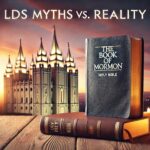The Seer Stone and the Translation Process: Why the LDS Church Didn’t Conceal It, But Didn’t Emphasize It
The use of seer stones in the translation of the Book of Mormon has become an increasingly discussed topic in recent years. For many members of The Church of Jesus Christ of Latter-day Saints (LDS Church), learning about Joseph Smith’s use of a seer stone rather than solely using the Nephite interpreters (often called the Urim and Thummim) has been surprising. Some have even asked whether the Church intentionally hid this information.
However, a careful look at historical records and church teachings suggests that the Church did not actively conceal the seer stone’s role but rather did not place emphasis on it. Like any history teacher who must decide which aspects of history to highlight, the Church has focused on the broader message of divine revelation rather than the mechanics of the translation process. This post will explore the history of seer stones, why they were often referred to as the Urim and Thummim, and why the Church prioritized the spiritual significance of the Book of Mormon over the specific method of translation.
Joseph Smith used multiple instruments to translate the Book of Mormon. Initially, he had the Nephite interpreters, described as “spectacles” buried with the gold plates. However, he also used a small brown seer stone, which he had previously used in treasure-seeking activities before his prophetic calling.
The process involved placing the stone in a hat to block out external light, after which Joseph would dictate the words he saw to his scribes. Though unfamiliar to modern audiences, this method was considered completely legitimate within the early 19th-century religious and folk-magic context.
Joseph and other early church leaders often referred to both the Nephite interpreters and the seer stone under the umbrella term of “Urim and Thummim.” This biblical phrase was used to describe divine instruments of revelation, and Joseph may have applied it to his seer stone to align his experience with scriptural precedent. Over time, members of the Church unfamiliar with the specifics assumed that the Urim and Thummim only referred to the Nephite interpreters, leading to the common belief that Joseph translated directly from the plates without a seer stone.
Religious institutions prioritize faith-building messages over historical minutiae. Just as history teachers must choose which events to emphasize in a limited classroom timeframe, the Church had to decide how best to convey the story of the Restoration. The core message—that Joseph Smith translated the Book of Mormon by the power of God—was always the priority.
In early church publications, such as missionary tracts and Sunday School materials, the story was often streamlined to focus on Joseph receiving the plates and translating through divine means. The inclusion of a seer stone, which had connections to folk magic, was not seen as necessary for faith-building purposes. This was not an act of deception but rather an editorial choice to focus on the spiritual rather than the technical details.
One reason members of the Church were unfamiliar with the seer stone’s role is that Joseph Smith and other early leaders used the term “Urim and Thummim” broadly. Because this term was more recognizable to biblical audiences, it was easier for members to accept than “seer stone,” which might have seemed strange to a 19th- or 20th-century audience.
In the past two decades, the LDS Church has been more open in discussing the translation process, including the use of the seer stone.
- 2013: The Church published the Gospel Topics essay “Book of Mormon Translation”, explicitly acknowledging the seer stone’s role.
- 2015: The Church released a photograph of one of Joseph Smith’s seer stones, published in the Ensign magazine and on its website.
- Current Lesson Materials: The Come, Follow Me curriculum now includes references to the seer stone and translation process, helping members gain a fuller historical perspective.
This shift has been part of a broader effort to provide a more complete and historically accurate narrative. The availability of primary sources, academic research, and public interest in early Church history has encouraged greater transparency.
The LDS Church did not hide the seer stone or the details of Joseph Smith’s translation process. However, like any institution that teaches history, it prioritized certain elements that were most relevant to its faith-building mission. The focus was always on the divine power behind the translation rather than the precise mechanics.
For many years, the interchangeable use of the term “Urim and Thummim” created misunderstandings, but this was not done with the intent to deceive. Rather, it was an adaptation of language that made sense within a biblical and religious framework.
Today, with greater access to historical sources and a commitment to transparency, the Church has made a concerted effort to include these details in its official teachings. This does not change the core message: that the Book of Mormon was translated by the gift and power of God. The specific method is interesting and historically significant, but it does not define the spiritual importance of the text.
Just as history teachers must decide what details to emphasize in a classroom, the Church has always focused on the message over the mechanics. The process of translation was miraculous, regardless of whether Joseph used Nephite interpreters, a seer stone, or direct revelation. The essential truth remains the same: the Book of Mormon stands as a testament of Jesus Christ, and the means of its translation, though fascinating, is ultimately secondary to its message.






One thought on “The Seer Stone: Why the LDS Church Didn’t Conceal It, But Didn’t Emphasize It”
Comments are closed.